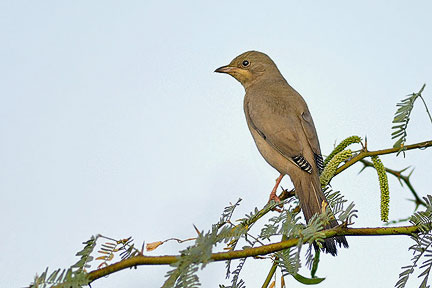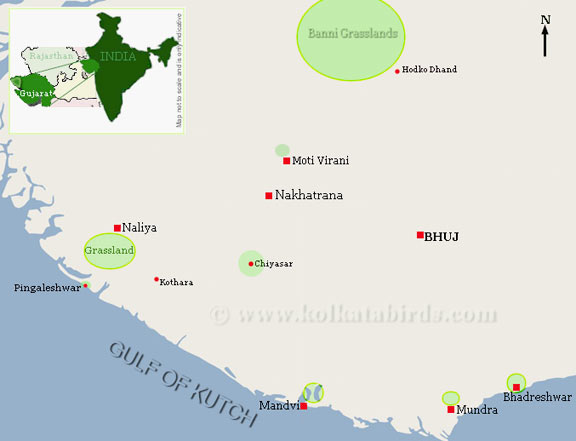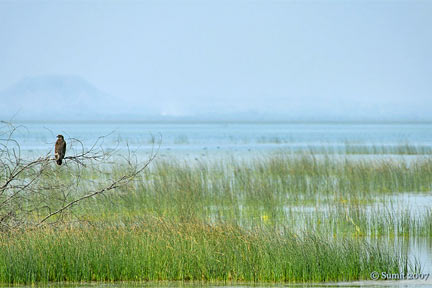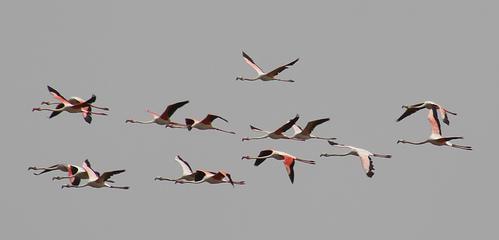
Kachchh(Kutch) mein gadein madey alag jhat jha pakshi aein . Maliney 370 jhat jha pakshi kachch mein malentah.
Kachchh birdlife is particularly rich in raptors, waterfowl, waders and larks. Specialties include the Grey Hypocolius (Kutch is the only known wintering site in India), White-naped Tit, Stoliczka’s Bushchat, Sykes’s Nightjar, Greater Hoopoe Lark, Merlin, McQueen’s and Indian Bustards. Over 30,000 Common Cranes, hundreds of Steppe Eagle, Marsh, Pallid and Montague’s Harriers, Long-legged Buzzards, Sandgrouse, Pelicans, Flamingos and great flocks of Greater Short-toed Larks are a feature of any winter visit to the area.
The Little Rann of Kutch is a bird watcher’s paradise in winter. Houbara bastard, sandgrouse, desert chat, desert wheat ear, nine species of larks, quails, gray francolin etc are seen in the saline desert wilderness. Eagles, vultures, harriers and falcons can be seen hunting in the Rann. The marshes in the Rann, and nearby lakes like Nawa Talao and Vanod Saran, attract huge flocks of water birds. Flamingoes, pelicans, cranes, storks, ducks etc can be seen in large numbers.More than 200 bird species live in these seasonal salt marshes. Three of these species are threatened: the lesser florican, Houbara bustard, and Dalmatian pelican. During the wet season, the marshes become pink with flamingos. This area is the home of the largest flamingo breeding colony in the world. Millions of these tall, pink birds fly here each year to nest and raise their young.
The Little Rann of Kutch is a birding paradise and has been declared a Ramsar Site. Birds here include Steppe, Imperial, and Short-toed Eagle, Houbara Bustard, flamingos, pelicans, storks and cranes. The best birding is during the winter months from October to March when waterfowl gather in vast numbers. These are the months when Demoiselle and Common Crane, and Lesser Flamingo are seen in incredibly large numbers.During the rainy season, you see a rich array of wildlife especially the pink flamingos which flock to acres of salt marsh flowering plants. Flamingos build clay nests that rise above the water. There, both parents tend the eggs. Flamingos feed while standing in shallow water. They lower their necks and tilt their heads so that their bills hang upside-down and face backward in the water. In this way they filter plankton, red and blue-green algae, insects, fish, mollusks, and small crustaceans from the water. This diet, mostly the red and blue-green algae and insects which are high in alpha and beta carotenoid pigments, is what causes the flamingos striking pink color.
Three-fourths of this eco-region is protected. Cattle grazing, cutting trees for fuel and commercial mining of salt all pose threats to the eco-region even those areas that are protected. People also drive across the mudflats, and their vehicles damage the fragile ecosystem.
Kutch birding hotspots

Banni Grassland and Chhari Dhand
Location: 69o24′ E 23o42′ N
Area: 3,847 sq. km
Habitat: Arid grassland interspersed with thorn scrub. The inherently saline soil, deposited by long lost river systems, is naturally suited for nutritious grasses. More than 20 grass species and 20 other herb and shrub species grow in Banni. ‘Banni’ comes from word ‘banai’, meaning made.
Chhari-Dhand is a seasonal wetland in the Banni. ‘Dhand’ means a saucer shaped natural depression. Chhari-Dhand is an important wintering area for a variety of waterfowl and is also a roosting place for over 30,000 Common Cranes in winter. A list of over 250 species of birds have been reported from the areas around Chhaari-Dhand.
Key species: Great place for many types of raptors and water dependent birds. Other key birds include Grey Hypocolius, White-naped Tit, McQueen’s Bustard and Dalmatian Pelicans.
Naliya Grassland (Lala Bustard Wildlife Sanctuary)
Location: 68o45′ E 23o30′ N
Area: 500 sq. km
Habitat: The habitat comprises of dry grasslands mixed with tropical and desert scrub and thorn forests.
Key species: This is a breeding area for the threatened Indian Bustard and about 20 birds are known to reside here. Other species include Lesser Florican, McQueen’s Bustard, Stoliczka’s Bushchat and nesting populations of Tawny EagleThe salt impregnated Great Rann of Kutch is a huge, flat expanse spreading over 16,000 sq km, interrupted occasionally by small uplands that are locally called bets (islands). The Rann owes its origin to a marine transgression and is a tectonically unstable area. Ecologically, it is one of the largest seasonal saline wetlands in the world, holding water that is upto a metre and a half deep during the monsoon. However, after October-November every year, the water begins to dry, transforming the area into a vast, saline desert. The wetland attracts a large number of waterfowl species like Flamingo, Pelican, Great Crested Grebe, Black Stork, Brahminy Duck, Common Pochard, Tuffed Pochard, White Eyed Pochard, Gulls, Terns, Stints, Plovers and others.
Chhari Dhandh (lying between the Banni grassland and Dinodhar Hill) is the largest of Kachchh’s almost three dozen dhandhs.Over 50 species of waterfowl can be found here, including the endangered Indian Skimmer and Dalmatian pelican. Enjoy a bird watching excursion to the wetlands of Chhari Dhandh where more than 50,000 waterfowls, 55 distinct animal species, 32 species of raptors, and some 30,000 birds have been recorded.
Naliya Bustard Sanctuary
Another significant grassland habitat of Kutch is the Great Indian Bustard Sanctuary at Lala near Naliya in Abdasa taluka. Though covering only about 2 sq km of area, this grassland is very important for birdwatchers as perhaps the only sanctuary in India where three species of bustard are found – the endangered Great Indian Bustard is resident here, the endangered Lesser Florican breeds here during the monsoon months, and the near-threatened Macqueen’s Bustard is a winter visitor. A variety of other birds like the Black and Grey Francolin, Spotted and Indian Sandgrouse, quails, larks, shrikes, coursers and plovers can be seen. This sanctuary is also interesting for birdwatchers as vulnerable species like the Stoliczka’s Bushchat and White-naped Tit could also be seen.
The sanctuary is important for birds of prey like the Imperial Eagle that visits in winter. The sanctuary extends north towards the creeks of Jakhau along the coast of Kutch where large flocks of flamingos, herons, egrets, sandpipers and other birds can be seen. Those with an with an interest in mammalian wildlife may see Wolf, Jungle Cat, Desert Cat and Chinkara (Indian Gazelle)For more info :
Kutch (Kachchh) Checklist of Birds : http://www.kolkatabirds.com/gujarat/gujaratclist.htm
Images of Birds of Kutch :http://www.kolkatabirds.com/gujarat/gujarat1.htm
Other Links :
http://www.kolkatabirds.com/gujarat/gujarat_tripreport.htm
http://www.kolkatabirds.com/gujarat/gujarattriplist.htm
http://www.kolkatabirds.com/sites.htm




I need a birding guide for little rann of kutch on 30th December and 31st December. Please respond.
Not Found
The requested URL was not found on this server.
Additionally, a 404 Not Found error was encountered while trying to use an ErrorDocument to handle the request.
Local Photography group on Facebook with very good photos of Birds of Kachchh
https://www.facebook.com/groups/photographyclubofgandhidham
More about WILDLIFE of KUTCH
1)
http://in.groups.yahoo.com/group/wildlifeofkutch/
http://www.geocities.ws/wildlifeofkutch/Index.htm
2)
http://in.groups.yahoo.com/group/kutchwildlife/
3)
http://in.groups.yahoo.com/group/wildkutch/
WILD KUTCH
wildlifeofkutch@yahoogroups.co.in
Information of the wild life of Kutch eg. Wild animals, Plants, Birds etc,
With goods friends and nature lover environmentalists we have started a group for a conservation of Kutch environment and the protection of our rare plants, wildlife and natural places in kutch region.
http://www.geocities.ws/wildlifeofkutch/Index.htm
http://www.geocities.ws/wildlifeofkutch/Links.htm
Team of people providing Birding And Wildlife Tour of Kachchh (Kutch)
http://www.waders.in
Lesser Flamingoes at Little Rann of Kutch in Kachchh, Gujarat, India
http://www.youtube.com/watch?v=e5G6Aom26R4&feature=related
Two day programme for Bird enthusiasts in Charridhand
http://news.kutchforever.com/ShowNews.aspx?id=103
Chhari Dhand is now officially Western Indias and Gujarats First Bird conservation Reserve
http://www.kutchmitradaily.com/News.aspx?id=33407